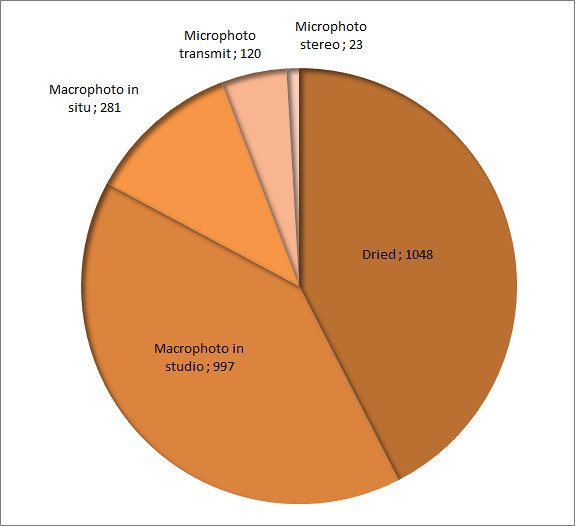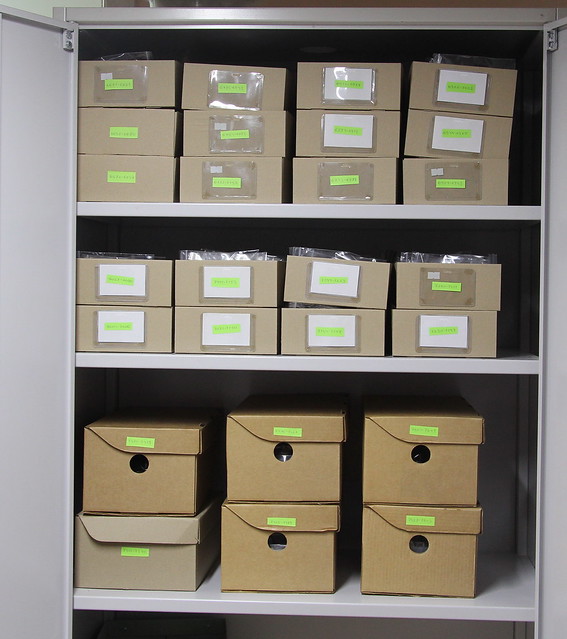Кто не знает сыроежек? — (я не знаю).. это какой-то цветной калейдоскоп из всякий раз разных видов.
На самом деле, по соотношению числа образцов к числу видов руссула оказался самым разнообразным (=2) если сравнить с другими недавно обработанными родами (клитоцибе = 3, гимнопус и паутинник = 4, галерина = 9). Собрано было 56 образцов сыроежек, определено 27 видов.
Сборы в этот раз достаточно хорошие, за что сама себя благодарила (бзз): сделаны споровые отпечатки, отмечены вкус, запах, описаны цвета и пр. Но на разбор этой коллекции у меня было всего несколько дней, решила отмикроскопировать только споры и на этом остановиться. Чтобы подробнее и надежнее разобраться в этом роде нужно микроскопировать еще поверхность шляпки с разными реактивами; и это как всегда остается на будущие тщательные проработки.
sect. Compactae — все образцы определены как R. acrifolia, хотя в поле были предварительные этикетки как R. adusta и R. nigricans. Все-таки сомневаюсь в различиях между ними, нужно будет еще приглядеться.
sect. Heterophyllae — здесь три вида с зеленоватыми шляпами. R. medullata обильно росла вдоль дороги в осиннике, споры с отдельными бородавками, отпечаток охристый. R. aeruginea часто встречалась в хвойных и смешанных лесах, споры с бородавками и небольшими перемычками, отпечаток кремовый. R. cf. atroglauca споры отличались от предыдущих видов большим количеством перемычек, но собран один экземпляр и возможна ошибка.
sect. Ingratae — R. foetens, хорошо узнаваемый валуй (споры с крупными бородавками без перемычек).
sect. Polychromae subsect. Integriforminae — два красных высоких вида с сереющими с возрастом плодовыми телами, отличаются орнаментом спор: R. decolorans с отдельными крупными бородавками и R. cf. rivulicola с перемычками.
sect. Polychromae subsect. Integroidinae — в этой секции один очень яркий желтый вид, собран несколько раз в осиново-березовых лесах — R. claroflava.
sect. Polychromae subsect. Polychromae — всего один вид в этой подсекции, собран в одном экземпляре, светло-вишневый, с желтыми пятнами на ноге, споры с бородавками и перемычками — R. cf. amethystina (сомневаюсь потому что один, не с чем сопоставить).
Polychromae subsect. Puellarinae — в этой секции с желтыми оттенками на ножке определилось четыре вида. R. puellaris хорошо отличается по интенсивно-коричневой ноге, R. sphagnophila по тонкой ребристой шляпке (собран в заболоченном березняке), также определен микоризный с березой вид R. versicolor с более толстой шляпой, и R. cf. sapinea — относительно крупный вид с коричневато-малиновыми оттенками, крупными спорами с отдельными бородавками (но пожелтения ноги отмечено не было).
Polychromae subsect. Urentes — один вид из подсекции, очень жгучий, споры с крупными отдельными бородавками, R. cf. badia (один плохо собранный экземпляр).
Polychromae subsect. Xerampelinae — R. xerampellina, собрана в одном усыхающем экземпляре, споры крупные с отдельными шипами.
В секции Russula определено девять видов разных красных оттенков. R. aquosa — малиновые небольшого размера сыроежки из хвойных лесов, R. rhodopus — малиновый крупный вид с розовой ногой в хвойных лесах, R. torulosa — небольшые с малиновой ногой плодовые тела, споры с бородавками и перемычками, R. gracillima похож на предыдущую, но споры с отдельными бородавками и растет в березняке, R. renidens еще одни внешне похожий, но споры мелко-бородавчатые с перемычками. Из красных видов этой секции часто встречалась R. grisescens (белый споровый отпечаток), R. depallens с быстро выцветающими шляпками из березняков, R. cf. emetica c ярко-алыми шляпами и спорами с выраженной сеткой (вкус не у всех образцов острый). Один НЕ красный вид в этой секции — коричневая R. consobrina.

.. на скорую руку получился коллаж из разноцветных шляпок:





















